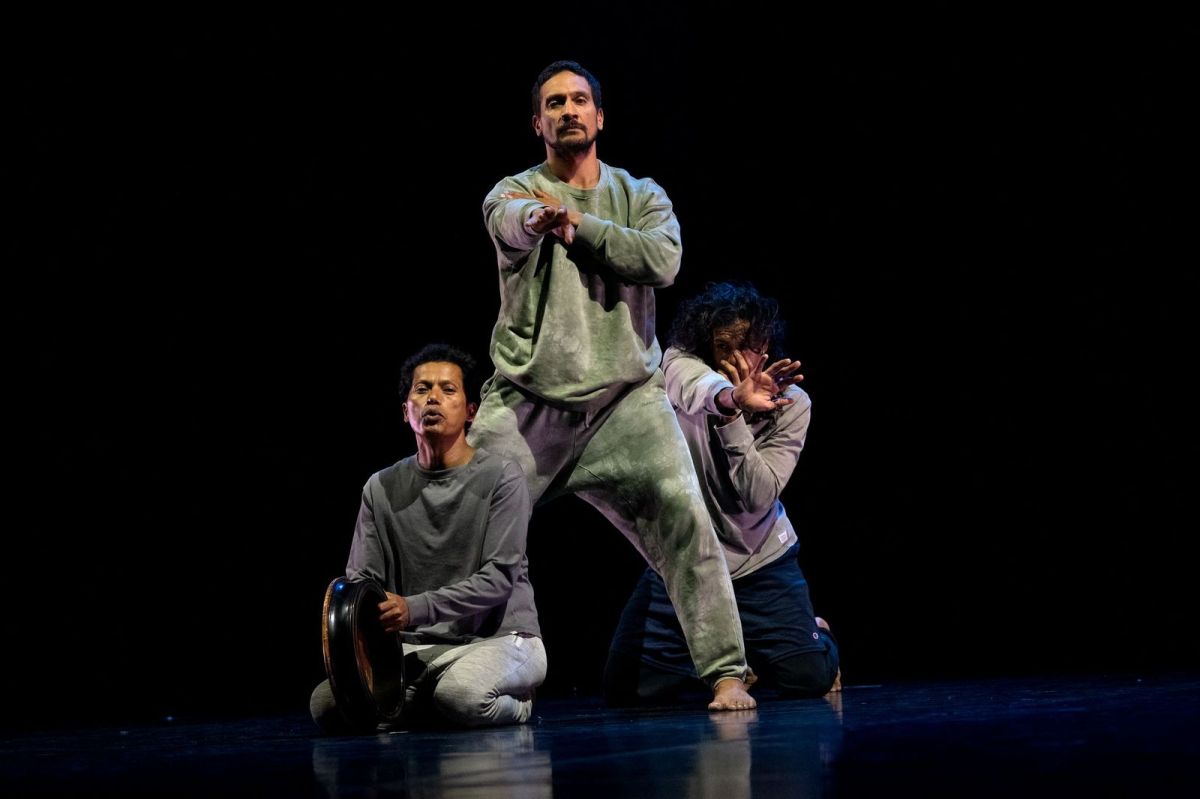Bunyi Bunyi Bumi was a challenging new dance commission for Asia TOPA 2025. Combining the creative talents of Aboriginal, Torres Strait Islander and Indonesian artists, the performance explored the connections between cultures predating colonialism and their place in the modern world.
“5, 4, 3, 2, 1, get in the car!” filled the audio space as a solo male performer brushed their teeth and then danced to the phrase that was repeated over and over. The mundane everyday sounds of a daily routine contrasted with the body on stage rebelling against the instructions. This unusual juxtaposition was disconcerting for the audience and set the scene. The voiceover of daily routine was an ongoing part of the show and, when combined with words in other languages, it became more and more painful to hear.
The dances were often accompanied by a syncopated soundtrack that created a distorted feel to what was being heard and impacted what was being seen on stage. This music, combined with the movement on stage induced feelings of turmoil and disruption.
Each of the three solo performers had a segment of the one-hour program to themselves and the feelings of isolation and pain for each were powerfully communicated through movement and occasional vocalisation.
When the dancers worked together as a trio there was a different energy; their connection to each other was amplified. The message of being better when working together was effective and showed up strongly in contrast to the seclusion faced when the dancers were alone. The ending with the three of them on stage was visually and emotionally striking, but also confusing in terms of what message it was trying to portray.
The stage had a series of ropes the images of which were broadcast throughout the show. When it worked well, these visuals added to the atmosphere and drama of the action, but they could also be distracting and took attention away from the performers. During the course of Bunyi Bunyi Bumi, the dancers also manoeuvred small, wheeled platforms of varying shapes around the stage.
There was a Tetris-like feel to them coming together that created a sense of satisfaction. Hand-held drums were also used, not just for percussion but as props for the dancers. All the various elements of the staging were well thought out and contributed to the whole.
The narrative was advertised as ‘a powerful rebuke of colonial amnesia’, but this didn’t come through as clearly as intended. It felt more like a rebuke of the isolationism of contemporary society and an encouragement to come back to our roots. The feeling that we’re better together and interconnected was a strong universal takeaway.
Read: Theatre review: Honour, Red Stitch Actors’ Theatre
Bunyi Bunyi Bumi was a wonderful example of how cultures coming together can make us stronger. This was shown both in the concept of the performance and in its execution. In a world that’s increasingly divided, the idea of connection is an important and powerful one.
Bunyi Bunyi Bumi
Studio, Bunjil Place
Co-Directors and Co-Devisers: raymond blanco (Yadhaigana and Erub) and Priya Srinivasan (Tamil)
Co-Devisers: Alfira O’Sullivan (Acehnese), Murtala (Acehnese), Waangenga Blanco (Meriam and Pajinka Wik), Tyrel Dulvarie (Yirrganydji)
Visual Design: Vernon Ah Kee (Kuku Yalanji, Waanji, Yidinji, Gugu Yimithirr)
Rehearsal Director: Josh Bond
Design Dramaturg: Govin Ruben (Malaysian Tamil)
Sound Designer: Samuel Pankhurst
Projection Designer: Sam James
Set & Costume Designer: Harry Gill
Lighting Designer: Kris Chainey
Outside Eye/Dramaturg: Katrina Irawati Graham (Indonesian)
Wellbeing and First Aid Support: Nix Gross (Quandamooka)
Bunyi Bunyi Bumi was performed 20-23 February 2025 as part of Asia TOPA.





